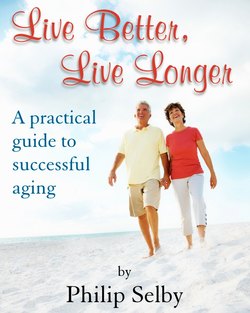Читать книгу Live Better, Live Longer - Philip Selby - Страница 4
Introduction
ОглавлениеToday, people live longer than ever before, as a result of better hygiene, food, and medical care. This fact provides a double challenge — an opportunity to make the most of the added years, and a greater need to cope with the disabilities of later life.
The International Health Foundation, which commissioned the work on which this book is based, thought it would be useful to provide the ordinary person with a simple guide to help meet these challenges. The book is not intended to be a textbook, but a practical guide for anyone interested in successful aging. As such it requires no specialized knowledge on the part of the reader. It is written in everyday language, and where technical terms are used they are explained.
Aging, in the strict sense, is a continuous process from cradle to grave. However, for children and most young adults middle age and old age tend to be rather remote, and eclipsed by the present. Most readers of this book are therefore likely to be people of mature years who have begun to think about preparing for the next phase of their lives, and how to achieve successful aging.
The term “successful aging”, used in this book, requires explanation. It implies preparing constructively for one’s later years in order to ensure happiness, self-fulfillment, and usefulness to others. It may be achieved in many ways: through preventing disease; being and staying physically and mentally active; coping with disabilities should they occur, and living as full a life as possible despite them; planning for economic and social well-being; and playing a meaningful role in society. Of course each of us must decide on our own goals and roles. This book does not presume to take over such decisions, but offers practical advice and guidelines which may help each person to find his or her own solutions according to individual needs and circumstances.
A guide such as this, intended for anyone interested in successful aging, must cover a wide range of circumstances. To those who are healthy, active, and economically and socially secure, certain parts may seem unduly pessimistic. To others, less fortunate, they may appear over-optimistic. For many people, growing old starts at the age of retirement. But while retirement age has remained the same for decades (or has even been lowered), life expectancy has been steadily increasing, and with it the age at which physical and mental decline might be expected to occur. At retirement you will still be relatively young and, barring ill fortune, able to plan for anything from a decade to a quarter of a century or more of active life.
The book is in three parts.
Part One is intended for everyone, since preparation for “successful aging” should start early and be a lifelong process.
Part Two offers suggestions for coping with various disabilities which are more likely to occur as you grow older. Where such a disability cannot be cured, “successful aging” means adapting to it and making the most of life in spite of it.
Part Three is written for those of any age who care for, or are considering caring for, an elderly person at home. Whether or not they undertake the caring role, and how well they carry it out, can have a great influence on the quality of life of an elderly person — enabling him or her to enjoy a measure of “successful aging” right up to the end of life, despite ill health or even some degree of incapacity.
This practical guide to successful aging is, in a sense, a guide on how to get the most out of life. It deals with preventing problems, but also with coping with them if they arise. This does not mean that all the problems will occur, indeed the chances are that they will not. The message is therefore one of hope and optimism. Old age can be a good age, but you must strive to make it so.
